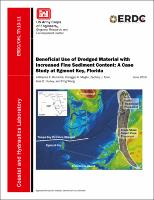Please use this identifier to cite or link to this item:
https://hdl.handle.net/11681/33363Full metadata record
| DC Field | Value | Language |
|---|---|---|
| dc.contributor.author | Brutsche, Katherine E. | - |
| dc.contributor.author | Tyler, Zachary J. | - |
| dc.contributor.author | Maglio, Coraggio K. | - |
| dc.contributor.author | Ousley, Jase D. | - |
| dc.contributor.author | Wang, Ping | - |
| dc.date.accessioned | 2019-07-10T13:10:10Z | - |
| dc.date.available | 2019-07-10T13:10:10Z | - |
| dc.date.issued | 2019-06 | - |
| dc.identifier.govdoc | ERDC/CHL TR-19-11 | - |
| dc.identifier.uri | https://hdl.handle.net/11681/33363 | - |
| dc.identifier.uri | http://dx.doi.org/10.21079/11681/33363 | - |
| dc.description | Technical Report | - |
| dc.description.abstract | In November 2014, Tampa Harbor Entrance Channel was dredged, and material was placed onto Egmont Key. Although the material contained quantities of fine sediment that were greater than the State of Florida “Sand Rule” criteria, an exception was made to allow placement of the sediment directly onto the beach due to the critically eroding west shoreline of the island. Material was placed in a traditional beach nourishment template at the northern portion of the island and in a cross-shore swash zone placement approximately 0.8 kilometer south of that. Beach profile surveys were collected to document morphology change of the two types of nourishments and to illustrate cross-shore location of each sediment sample. Core borings and surface sediment samples were collected and analyzed to quantify fines loss from sediment source to placement site. Although the core borings taken in the dredging area indicated an average of 20.7% fines, the surface sediment samples on the dry beach only yielded 1.9% fines on average, which is within the Florida “Sand Rule” regulation. The post-construction surface sediment samples had a similar color to the pre-construction samples. | en_US |
| dc.description.sponsorship | United States. Army. Corps of Engineers. | en_US |
| dc.description.tableofcontents | Abstract .................................................................................................................................... ii Figures and Tables .................................................................................................................. iv Preface ...................................................................................................................................... v Unit Conversion Factors ......................................................................................................... vi 1 Introduction ...................................................................................................................... 1 1.1 Background ........................................................................................................ 1 1.2 Objectives ........................................................................................................... 2 1.3 Approach ............................................................................................................ 2 2 Study Area ......................................................................................................................... 3 2.1 General setting .................................................................................................. 3 2.2 Geologic setting ................................................................................................. 4 2.3 Meteorological and oceanographic conditions ................................................ 5 2.3.1 Winds ........................................................................................................................... 5 2.3.2 Waves .......................................................................................................................... 6 2.3.3 Tides ............................................................................................................................ 8 3 2014–2015 Dredging and Placement Operations ...................................................... 9 4 Methodology ................................................................................................................... 11 4.1 Geotechnical core borings ..............................................................................11 4.2 Surface sediment sampling ............................................................................ 14 4.2.1 Collection methods ................................................................................................... 14 4.2.2 Sieving ....................................................................................................................... 15 4.2.3 Munsell Color ............................................................................................................ 15 5 Results and Discussion ................................................................................................. 17 5.1 Core borings ..................................................................................................... 17 5.2 Beach profile surveys and surface sediment samples ................................. 17 5.3 Core boring and sediment sample summary ................................................. 21 6 Conclusions .................................................................................................................... 22 References ............................................................................................................................. 23 | - |
| dc.format.extent | 34 pages / 6.990 Mb | - |
| dc.format.medium | - | |
| dc.language.iso | en_US | en_US |
| dc.publisher | Coastal and Hydraulics Laboratory (U.S.) | en_US |
| dc.publisher | Engineer Research and Development Center (U.S.) | - |
| dc.relation.ispartofseries | Technical Report (Engineer Research and Development Center (U.S.)) ; no. ERDC/CHL TR-19-11 | - |
| dc.rights | Approved for Public Release; Distribution is Unlimited | - |
| dc.source | This Digital Resource was created in Microsoft Word and Adobe Acrobat | - |
| dc.subject | Beach nourishment | en_US |
| dc.subject | Dredging | en_US |
| dc.subject | Dredged material | en_US |
| dc.subject | Dredged material--Management | en_US |
| dc.subject | Dredging spoil | en_US |
| dc.subject | Egmont Key (Fla.) | en_US |
| dc.title | Beneficial use of dredged material with increased fine sediment content : a case study at Egmont Key, Florida | en_US |
| dc.type | Report | en_US |
| Appears in Collections: | Technical Report | |
Files in This Item:
| File | Description | Size | Format | |
|---|---|---|---|---|
| ERDC-CHL TR-19-11.pdf | 7.16 MB | Adobe PDF |  View/Open |